This post may contain affiliate links. Please read our disclosure policy.
Simmered daikon radish with chicken is a winter comfort food in Taiwan and Japan. This light and refreshing homestyle dish tastes savory, mildly sweet, light, and aromatic with notes of sweet and tangy citrus from a drizzle of yuzu juice.
Daikon radish is simmered in chicken stock with ginger, mushrooms, and chicken thighs for a low-calorie dish loaded with fiber, lean protein, and comforting flavors. This easy daikon radish recipe is perfect for those new to this versatile Asian veggie.
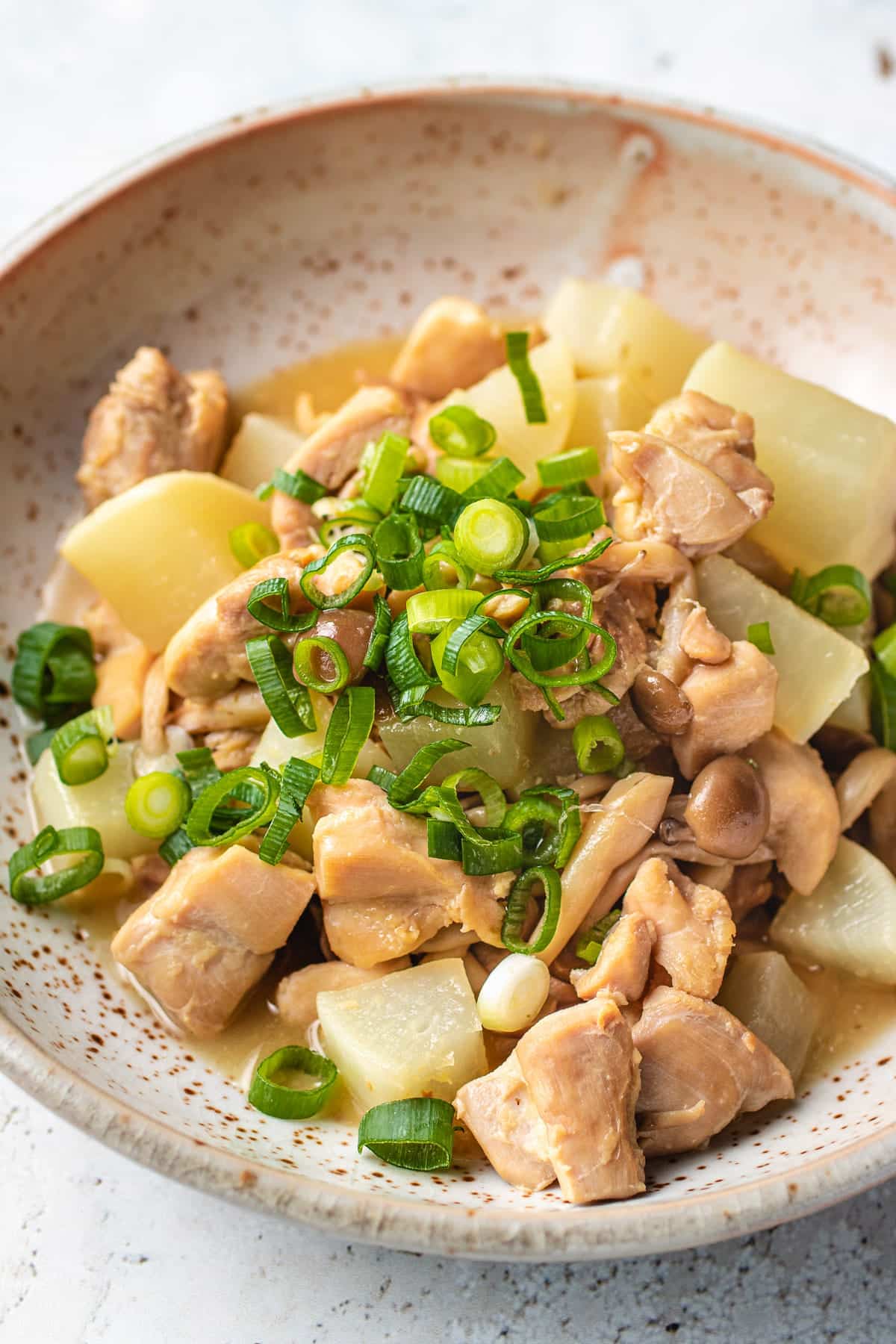
Table of Contents
Ingredients
This easy braised daikon dish uses a few, simple ingredients yet the result is deeply comforting. In Asia, this dish is commonly made in homes during the wintertime, served with steamed white rice. Here’s what you need for this simple and refreshing daikon vegetable recipe with chicken.
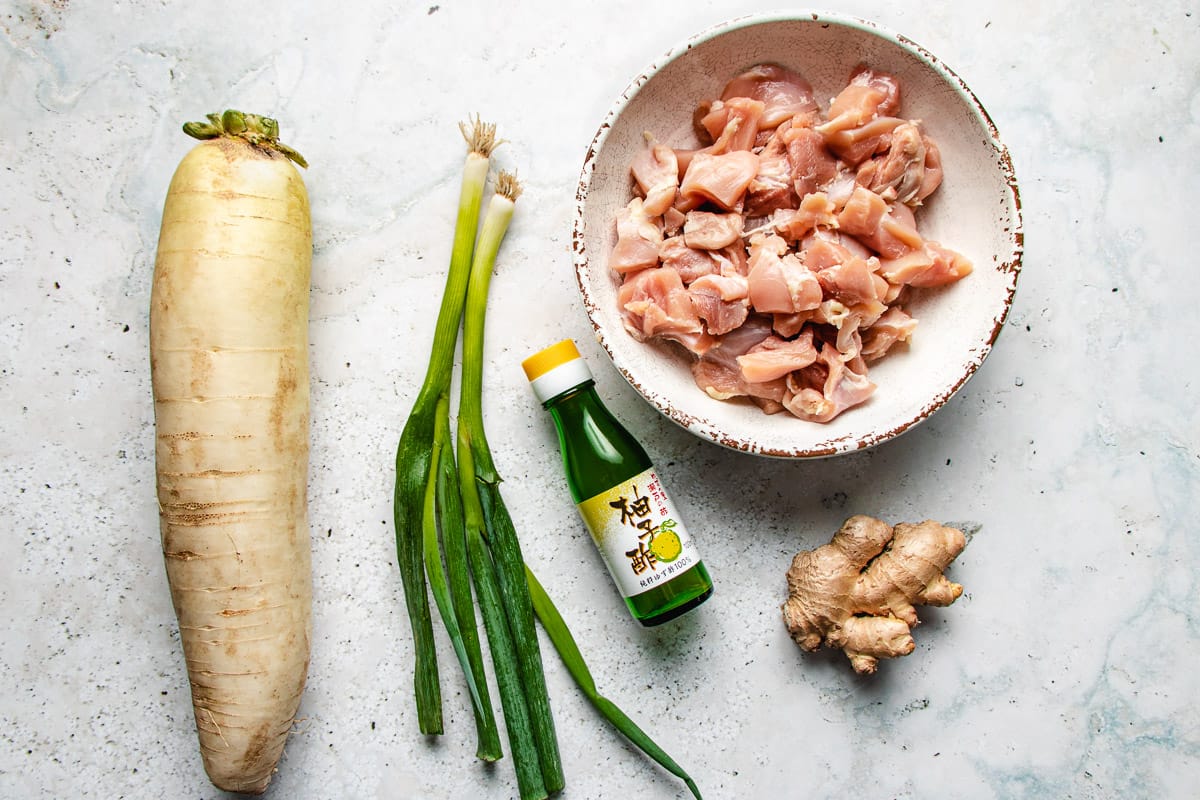
- Daikon radish: You can find daikon in Asian or Western grocery stores. Choose a radish that feels firm and heavy.
- Substitution: If you can’t find daikon, use white turnip instead. They have a peppery flavor and are less sweet than daikon.
- Chicken thighs: Boneless and skinless thighs add healthy protein, fats, and flavor to this homestyle dish.
- Beech mushrooms: You can use brown, white, or a mix of both. These are optional but add a nice texture and flavor to the dish.
- Substitution: You can also use fresh shitake mushrooms.
- Grated ginger
- Tapioca starch: Used to thicken the broth.
- Avocado oil
- Coarse sea salt
- Chicken stock: Used as the base for braising the daikon.
- Yuzu juice: Asian citrus juice similar to lemon or lime with fruity notes. Used as a garnish.
- Substitution: Mix equal parts lemon and lime with a splash of orange or grapefruit juice.
- Soy sauce
- Substitution: Use coconut aminos if gluten-free or soy-free.
- Scallions: Chopped and used as a garnish.
How to prepare daikon radish
- Trim the Ends: Start by cutting off both ends of the daikon radish. This makes it easier to handle.
- Rinse and Scrub: Rinse the daikon under cool tap water. Give it a gentle scrub with your hands or a vegetable brush to remove any dirt or debris.
- Peel the Skin: Use a vegetable peeler to remove the thin outer layer of skin. The skin can be a bit tough, so make sure to peel all around the radish.
- Cut as Needed: Depending on your recipe, you can cut the daikon into rounds, cubes, slices or matchsticks, or grate it. For most dishes, dicing into 1 to 1 ½-inch cubes is common.
- Optional Soak: If the peppery daikon taste is too strong, you can soak the cut pieces in water for about 15-30 minutes before cooking. This step is optional but can help mellow the flavor.
How to cook daikon with chicken
Japanese-inspired simmered daikon is a very easy recipe to make. Simmered or boiled radishes elevate soups and other dishes with a beautiful clean flavor and sweet, peppery notes. Here are the easy instructions with notes on how long to cook daikon for optimal texture.


- Prep the daikon: After removing the ends, rinse, scrub, and dry your daikon. Peel the skin and then dice into 1 to 1 ½ -inch cubes.
- Prep other ingredients: Dice the chicken, clean and trim the mushrooms (if using), grate the garlic, and make a slurry using the starch and water.


- Saute the chicken: In a large, preheated wok or skillet, saute the chicken with oil, ginger, and salt over medium-high heat for about 3 minutes.
- Combine and simmer: Add stock, daikon radish, and mushrooms, distributing them evenly. Cover with a lid and bring to a boil. Lower the heat and simmer until daikon is cooked (soft, but not mushy, and slightly translucent and pale in color).


- Season and thicken: Season with yuzu juice and soy sauce. Add the slurry mixture and stir for 30 seconds to thicken the sauce. Taste and adjust seasonings as needed.
- Garnish and serve: Transfer them to a large serving plate. Garnish with scallions. Serve warm with a bowl of steamed rice.
Daikon cooking time: After bringing ingredients to a boil, simmer for 15-20 minutes. It takes about 30 minutes total to cook daikon, depending on how thick you cut it.
How daikon is used in Asian cooking
Daikon radish is a staple in Asian cooking, valued not just for its taste but also for its health benefits. It’s known for its detoxifying properties, helping to eliminate fats and excess toxins, aiding digestion, and improving blood circulation.
There are many ways to enjoy this versatile root vegetable. In Asia, the most common method is to add daikon to soups or braised dishes. When cooked, daikon becomes mildly sweet, and its natural peppery flavor softens, making it a comforting addition to any meal.
In the summer, pickling daikon is also a popular option, offering a crisp and tangy side dish.
Raw grated daikon, with its refreshing and slightly spicy taste, shredded daikon is often served with fried foods like Japanese katsu to cleanse the palate. Or use it in a salad or daikon slaw.
Unlike Western radishes, daikon is rarely roasted in Asian cuisine. This is because daikon is less spicy, bitter, and pungent than its Western counterpart, making it perfect for other cooking methods.
What to serve with it
This tasty simmered daikon recipe is a nourishing and comforting meal often served over steamed white rice. It’s full of healthy protein and fiber. Here are some delicious pairing options if you want to serve it as part of a larger meal.
- Rice: Air fryer fried rice is an easy and simple option, or try shirataki fried rice for low-carb. For basic steamed rice see my post on how to cook rice in a rice cooker.
- Pickles/Kimchi: Asian pickled cucumbers are a tangy, sweet, and subtly spicy side dish that livens up any meal. Quick and easy cucumber kimchi or bok choy kimchi are also great!
- Vegetarian: This buttery soft eggplant tofu with garlic basil sauce is such a treat! Or keep things simple with garlicky bok choy stir fry or tender stir-fried broccoli with garlic sauce.
ChihYu’s expert tips
- Cut Daikon Evenly: Make sure to dice the daikon into uniform pieces, about 1 to 1 ½ inches thick. This ensures they cook evenly and achieve the perfect tender texture.
- Peeling the Daikon: Always peel the daikon before cooking. The outer skin can be tough and slightly bitter, so removing it will help the daikon cook more evenly and absorb flavors better.
- Simmering Time: Daikon needs to be simmered until it’s fork-tender and slightly translucent. This usually takes about 30 minutes. If it’s not cooked long enough, the texture will be too firm and the flavors won’t fully develop.
- Cooking Daikon: When adding daikon to soups or stews, make sure the pieces are fully submerged in the liquid. This allows them to absorb the flavors and cook through properly.
- Cookware Size: Use a pot or pan that’s just big enough to hold all the ingredients plus the liquid. A 4-quart Dutch oven or a wok pan with a lid is ideal.
- Using Daikon: Daikon is incredibly versatile. It can be cooked in soups, stews, or stir-fries, or served raw in salads. You can also pickle it for a tangy side dish. See our other daikon recipes below.
FAQs
Daikon is an Asian radish used in soups, stews, or stir-fries, where they become tender and mildly sweet. They’re also great raw in salads or pickled for a tangy side dish. Due to their versatility, they are used in many Asian daikon dishes.
Daikon radish has a mild, slightly sweet flavor with a subtle peppery bite. When cooked, it becomes tender and sweeter, losing much of its initial sharpness.
Yes, you can eat daikon radish raw. It has a crisp texture and a refreshing, slightly peppery flavor, making it perfect for salads, slaws, or as a crunchy garnish.
Daikon is delicious both cooked and raw, depending on how you want to use it. Cooked daikon becomes tender and sweet, making it great for soups and stews, while raw daikon offers a crisp, peppery crunch perfect for salads and garnishes.
More recipes using daikon
If you’re new to using this versatile Asian radish or just want to incorporate it more for its many health benefits, give these other daikon radish recipes a try!
- Chinese beef stew with daikon is another hearty and warming winter favorite with tender beef and sweet, peppery daikon.
- Jiaozi (Chinese potstickers) made with daikon wrappers are a Paleo and gluten-free appetizer perfect for any family-style meal or party spread.
- Pork rib soup with daikon is an iconic Chinese soup made with tender baby spare ribs and daikon radish in an Instant Pot
- Pickled daikon is a tangy and refreshing side dish with shredded daikon and carrots.

Simmered Daikon Radish with Chicken recipe

Ingredients
- 1 lb. Daikon radish
- 1 lb. Chicken thighs boneless and skinless
- 3.5 oz brown or white beech mushroom optional
- 1 tsp arrowroot starch
- 1.5 tbsp avocado oil
- 2-2.5 tsp grated ginger
- 1 tsp coarse sea salt plus more to taste
- 1 cup chicken stock
- 1 to 1.5 tbsp yuzu juice see notes for substitute
- 1 tbsp soy sauce or 1.5 tbsp coconut aminos
- 1-2 bulbs scallions chopped
Instructions
- PREPARE DAIKON: Slice off both ends of the daikon radish. Rinse and scrub the turnip under tap water. Pat dry and use a peeler to peel off the thin outer skin. Dice it into cubes, about 1 to 1 ½ -inch thick.
- PREPARE CHICKEN & MUSHROOMS: Dice the chicken to 1 ½ -inch bite sizes. Slice off the bottom end of the mushrooms and use your hands to separate them into pieces, if using.
- PREPARE GINGER & STARCH: Grate the ginger and set aside ready to use. In a small bowl, make a slurry with starch combined with 1.5 tbsp water.
- SAUTE CHICKEN: Preheat a 4-quart Dutch oven or a wok pan with a lid over medium heat until it feels warm. Add the oil, chicken, ginger, and salt. Saute over medium-high heat for about 3 minutes.
- STOCK, DAIKON, MUSHROOMS: Add stock, daikon radish, and mushrooms. Distribute the radish evenly and make sure the pieces are in contact with the liquid. Cover with a lid and bring it to boil, about 3-4 minutes.
- SIMMER: After boiling, drop the heat to medium-low and simmer for 15-20 minutes. The daikon is cooked when you can easily poke it through with a fork or chopstick. You can easily break it apart without much resistance. The color will also turn from pale white to light translucent.
- Stir the pot periodically to ensure even cooking.
- SEASON & THICKEN: Season with yuzu juice and soy sauce. Stir the slurry one more time before adding it to the pot. Gently toss for 30 seconds to thicken the sauce. Turn off the heat, taste and add more salt, if needed.
- GARNISH: Transfer them to a large serving plate. Garnish with scallions. Serve warm with a bowl of steamed rice.
Notes
- Yuzu Juice Substitute: Mix equal parts lemon and lime juice with a splash of orange or grapefruit juice.
- Yuzu juice tastes sour like a mix between lemon juice, bitter grapefruit, and orange.
- Daikon Substitute: Use white turnip instead. It has a stronger peppery taste, but it’s a good alternative and will give you a similar flavor.
- Mushroom Substitute: Swap beech mushrooms for fresh shiitake.
- Cookware Size: Use a pot or pan that’s just big enough to hold all the ingredients plus the liquid. A 4-quart Dutch oven or a wok pan with a lid is ideal.
- Storage & Freeze: This dish tastes even better the next day. Both the daikon and chicken freeze well.
Nutrition
Nutrition information is automatically calculated, so should only be used as an approximation.
Made a dish and loved it? Please rate the recipe and leave a comment in the section below! It helps my blog grow organically, allowing me to continue sharing free and awesome content with you. Thank you!
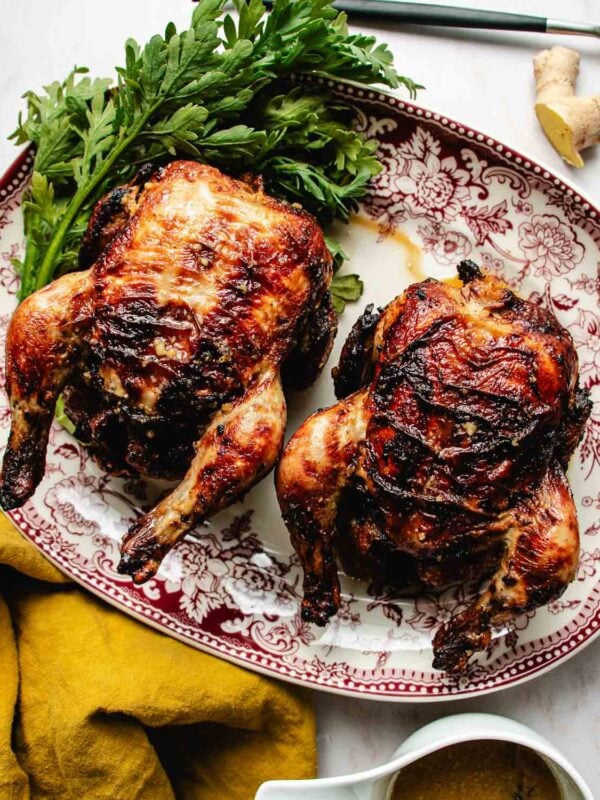
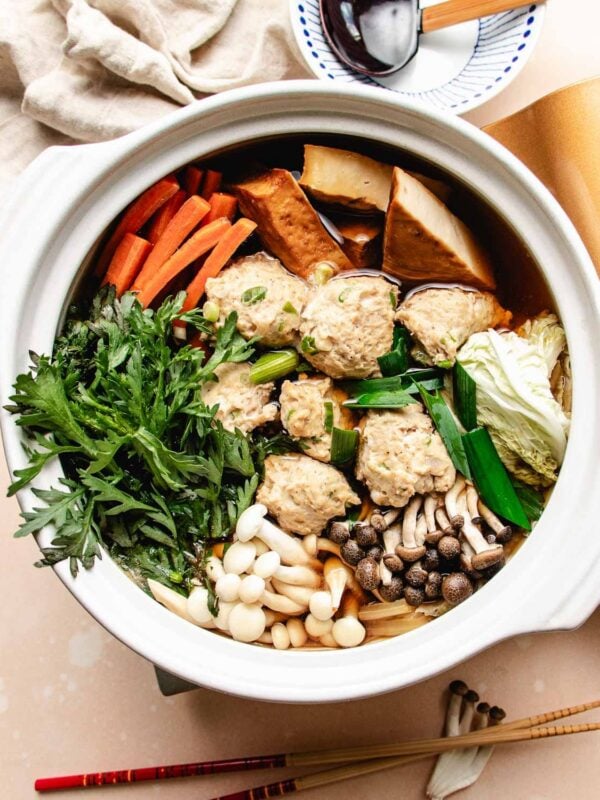

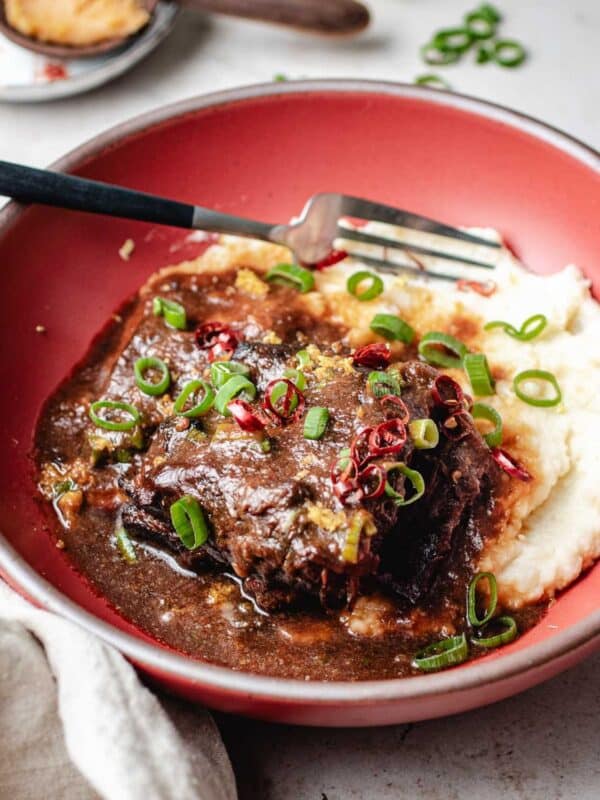









I have made this dish countless times and it’s a favorite. I actually double the broth to make it more of a soup and do not add potato or corn starch. I found yuzu juice at an Asian market but have also mixed lemon and lime juice as an alternative. Serve it with a little rice-perfection. Highly recommend!
Thank you, Alice. We love daikon. Goes well with everything, especially chicken or baby pork ribs in my opinion!
This recipe was delicious – yuzu is delicious and so is coconut aminos aka coconut nectar seasoning – daikon is also amazing just a mild radish – delish – I just love stir fry’s and this is by far the most flavorable
This recipe is so easy and so amazing. It is such a comfort food when served over rice. It’s like the Asian chicken and rice. I love it so much. I’ve substituted lemon juice and soy with great results. I’ve made it twice and it is on my winter rotation!
Wonderful. So glad you give daikon a try!
What a great recipe! Thank you for outlining a few of the substitutions for coconut aminos and yuzu juice so don’t let that scare you away. Really easy and very tasty. I did toss in a small chopped onion into the pan a few minutes before the stock got added as I didn’t have any scallions for a final touch. Chihyu is right on with the Daikon Radish ending up with a lovely lightly sweet undertone. This dish is going into our short list rotation! I did toss it on top of some brown rice which was a great combo. Thank you Chihyu! Awesome dish!
Thank you, David! This is a simple and humble family meal and healthy, too! 🙂
Hi. May I ask, does this freeze well after cooked?
Yes! It’s perfect!